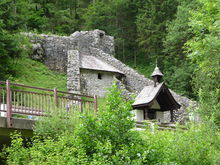Valley pass (narrow valley)
The valley pass , also known as bottleneck , describes a bottleneck in the terrain that requires special measures to open up traffic. It is not a geographically defined type of terrain . Valley passes are either so narrow that there is only room for the running water or a lake in the area of the valley floor, or historically there are other non-traversable topographies that require a bypass, such as swamp areas in the valley floor.
Paths and roads are then either laid in the edge of the valley, on dams or in one of the valley flanks above the valley floor, or the narrow point is bypassed via a nearby mountain pass (then the valley section and mountain pass are often called the same). In modern times, routes are increasingly being laid in tunnels through mountain slopes and ridges.
Historically, when lakes and rivers were available, goods were transported - wherever possible - on water and hardly ever on paths and roads; even with rivers in both directions, as long as this was feasible. This meant that certain valley passes could be bypassed in at least one direction; Rafted wood, for example, was loaded with goods on the Alpine Rhine from Reichenau to Rheineck , after the Rhine had been a free imperial road since 1291 (analogy to the free imperial city ).
The synonymous term Klause can be found in place names .
Well-known valley passes


- (Sorted by alphabet)
- Aare Gorge between Meiringen and Innertkirchen as access to the Susten Pass and Grimsel Pass (Canton Bern, Switzerland), around 80 meters above the river.
- Eisacktal (historical) between Bozen (232 m) and Kollmann / Waidbruck (South Tyrol):impassablebetween Roman times ( Via Raetia ) and the 14th century (construction of the Kuntersweg ), route over the Renon (over 1000 m).
- Finstermünzpass in the Inn Valley between Nauders and Landeck (Tyrol, Austria)
- Bypassing the mass of the Flims landslide on Hauptstrasse 19 between Reichenau (599 m) and Ilanz (698 m) via Flims (Canton of Graubünden, Switzerland), culminating at 1108 meters, more than 400 meters above the Vorderrhein and the Rhine Gorge - example for a valley pass bypassed by a mountain pass.
- Kerenzerberg am Walensee between Mollis and Mühlehorn (Canton Glarus, Switzerland), 324 meters above the lake - example of a valley pass by a lake.
- Klobensteinpass , which bypasses the so-called Antenloch between the Austrian Kössen and the Bavarian Schleching , a bottleneck of the Großache / Tiroler Achen.
- Kniepass on the Saalach near Unken , Kniepass on the Lech in Tyrol - are named after the striking river bend of the narrow point.
- Pass Lueg , Salzachöfen in the Salzach Valley south of Hallein ( Golling an der Salzach / Werfen , State of Salzburg) - four kilometers of route, dam structures, federal road and railroad cover the entire existing bank, the actual Lueg Pass is a short hill about 50 meters above the river; the Tauern motorway shortens the S-shaped valley narrow in two tunnels and spans the valley with bridges.
- Mandlingpass in the Ennstal between Radstadt and Schladming (Province of Salzburg / Styria, Austria).
- Rotenturm Passin the Olt Valley southeast of Sibiu (Southern Carpathians, Romania).
- Scharnitzpass in the Isar valley between Mittenwald (Bavaria, Germany) and Seefeld (state Tyrol, Austria) - no elevation of the Seefelder Straße (E 533), the pass of which is on the Seefelder Sattel .
- La Schlucht between Munster (Haut-Rhin) and Gérardmer in the Vosges, today's regional border between Lorraine and Alsace and formerly between France and the German Empire . Language border between Romance and German languages. La Schlucht is a narrow point in the ridge line and thus became the highest, but not a historical, pass in the Vosges. It has only existed since the second half of the 19th century, when a road (1857) and later two tram lines were laid out separately on both sides of the pass (1903, 1907).
- Steinpass on the Saalach , German-Austrian state border ( Kleines deutsches Eck ), the old mule track on the bank used to be bypassed with a pass (pass height 100 m above the valley floor) near Melleck, today there is a top tunnel - the valley pass and pass crossing have the same name.
- Pass Strub Lofer - Waidring (Salzburg / Tyrol) - bottleneck with old border fortifications, the valley watershed , unnamed as such, is located directly in Waidring.
- Twenger valley pass in the Lungau Taurach valley between Mauterndorf and Obertauern (State of Salzburg, Austria).
See also
credentials
- ^ Markus Kaiser: Rhine. In: Historical Lexicon of Switzerland . August 27, 2013 , accessed June 13, 2019 .
- ^ Official homepage of the Munster community